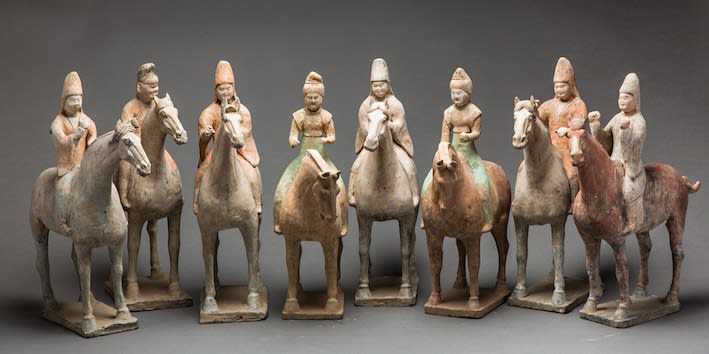Tang Processional Set of Eight Polychrome Horse and Riders, 618 CE - 906 CE
Ceramic, Pigment
34.9 x 33 cm
13 3/4 x 13 in
13 3/4 x 13 in
X.0421
Further images
The T’ang Dynasty was an era of unrivalled wealth and luxury. The country was successfully reunified and the borders were expanded, pushing Chinese influence into new lands. Confucianism became a...
The T’ang Dynasty was an era of unrivalled wealth and luxury. The country was successfully reunified and the borders were expanded, pushing Chinese influence into new lands. Confucianism became a semi-religious instrument of the state; yet Buddhism continued to flourish, spreading into Korea and Japan. The arts reached new levels of sophistication. Poetry and literature flourished under the enlightened rulers. The Silk Road brought fortunes into China. Precious treasures were imported on the backs of camels from far away lands and bartered for Chinese silk, medicinal herbs, and pungent spices. T’ang China was a multicultural empire where foreign merchants from across Central Asia and the Middle East settled in the urban centers, foremost among them the thriving capital of Chang’an (modern X’ian), a bustling cosmopolitan center of over two million inhabitants. Foreign traders lived next to native artisans and both thrived. New ideas and exotic artistic forms followed alongside. The T’ang Dynasty was a cultural renaissance where many of the forms and objects we now associate with China were first created. Moreover, this period represents one of the greatest cultural outpourings in human history.
This general type of Chinese burial art is known as mingqi. Mingqi were any of a variety of objects specifically created for interment in the tombs of elite individuals in order to provide for the afterlife. Here, we are witness to an elaborate procession. Perhaps even the funeral procession that carried the deceased into his tomb, where these painted terracotta figures were unearthed centuries later. Most likely, these works were dedicated to a member of the royal elite and we can imagine masses of citizenry lining up to catch a glimpse of this procession. Some riders appear to be government officials, and others, entertainers or family members. Both the horses themselves and the riders are colorfully painted in bright polychrome hues. While parades such as represented by this set were certainly not unknown in T’ang China, they must have been special occasions reserved for religious ceremonies or other such special circumstances. While this procession set may memorialize an event from jovial than funeral rites, their discovery inside a tomb reveals their connection with the afterlife. Perhaps this set was interred in order to welcome the deceased into the world beyond.
This general type of Chinese burial art is known as mingqi. Mingqi were any of a variety of objects specifically created for interment in the tombs of elite individuals in order to provide for the afterlife. Here, we are witness to an elaborate procession. Perhaps even the funeral procession that carried the deceased into his tomb, where these painted terracotta figures were unearthed centuries later. Most likely, these works were dedicated to a member of the royal elite and we can imagine masses of citizenry lining up to catch a glimpse of this procession. Some riders appear to be government officials, and others, entertainers or family members. Both the horses themselves and the riders are colorfully painted in bright polychrome hues. While parades such as represented by this set were certainly not unknown in T’ang China, they must have been special occasions reserved for religious ceremonies or other such special circumstances. While this procession set may memorialize an event from jovial than funeral rites, their discovery inside a tomb reveals their connection with the afterlife. Perhaps this set was interred in order to welcome the deceased into the world beyond.













